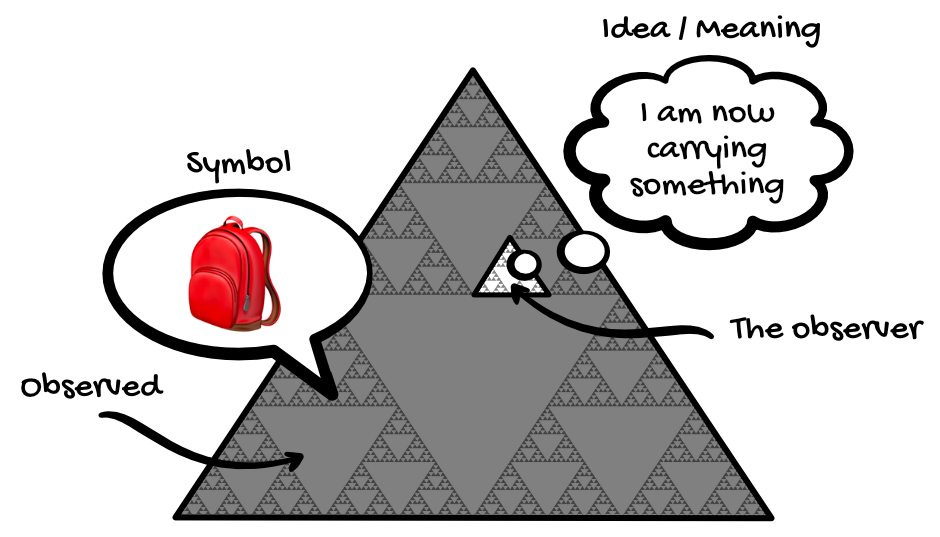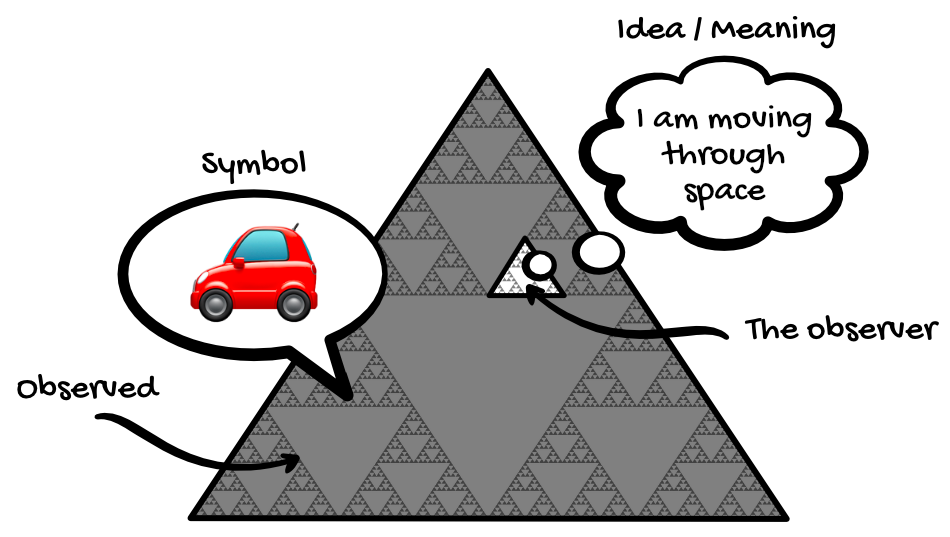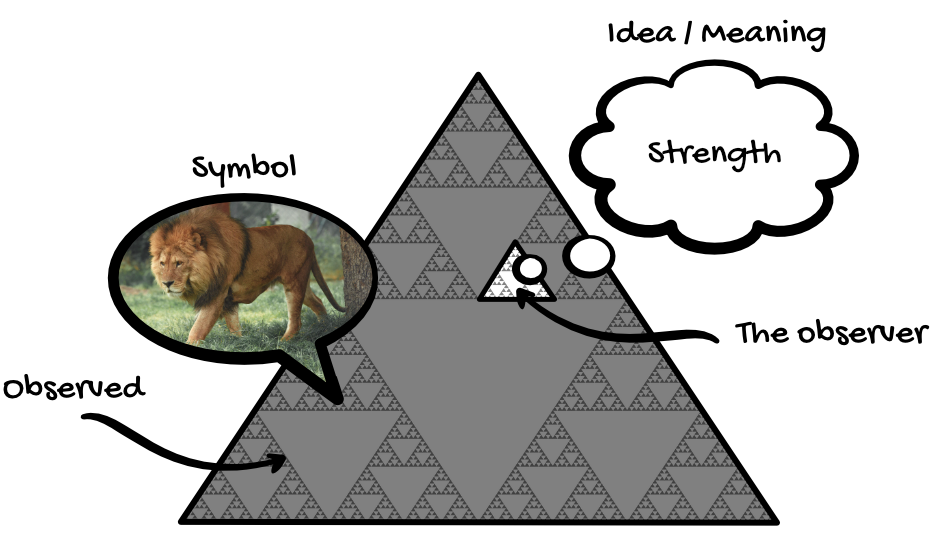"Now, I want to move on to my second point regarding that previous passage we read from The Holographic Universe. Here's the snippet again."
Even the symbolic language of the psyche is given "objective" form. For example, one of Whitton's subjects said that when he was introduced to a woman who was going to figure prominently in his next life, instead of appearing as a human she appeared as a shape that was half-rose, half-cobra. After being directed to figure out the meaning of the symbolism, he realized that he and the woman had been in love with one another in two other lifetimes. However, she had also twice been responsible for his death. Thus, instead of manifesting as a human, the loving and sinister elements of her character caused her to appear in a hologramlike form that better symbolized these two dramatically polar qualities.
Whitton's subject is not alone in his experience. Hazrat Inayat Khan said that when he entered a mystical state and traveled to "divine realities," the beings he encountered also occasionally appeared in half-human, half-animal forms. Like Whitton's subject, Khan discerned that these transfigurations were symbolic, and when a being appeared as part animal it was because the animal symbolized some quality the being possessed. For example, a being that had great strength might appear with the head of a lion, or a being that was unusually smart and crafty might have some of the features of a fox. Khan theorized that this is why ancient cultures, such as the Egyptian, pictured the gods that rule the afterlife realm as having animal heads.
Michael Talbot
"This concept of symbolism is incredibly important. It ties back to Carl Jung's work on the archetypes that surface in dreams and mythology. Michael Talbot wrote: '[In the after-life realm] many [NDEers] say that they were not aware of any form and were simply 'themselves' or 'their mind.' If my consciousness is a pure mathematical structure, then my physical body is just a symbol. It is a physical representation of a conceptual idea about myself.
But if everything is a mathematical structure, then everything in our physical reality is a symbol. When I interact with you, that interaction is a physical representation of the idea of communication. According to NDEers, in the light realms, communication happens instantaneously and telepathically, like receiving a non-linear data download."
"So, this backpack is a symbol of an idea, too?" Zac asked.
"Yes. It symbolizes the idea of carrying something. When you exist as a purely non-physical mathematical structure in the light realms, you could just think, 'I am carrying fruit,' and you'd conceptually be carrying fruit. But this realm is designed to give you a physical experience of your own self-concept. Therefore, you need to interact with a physical symbol of 'carrying' to believe that you're carrying fruit. You can't just have the fruit hover next to you as you walk. So, if you want to carry fruit from A to B, you need to interact with a symbolic representation of carrying fruit from A to B."
"So when I put my backpack on my back, my consciousness observes that symbol and interprets its meaning as, 'I am now carrying something?'"
"Yes," I confirmed. "In this way, the backpack manifests in your outer reality as a physical symbol of the conceptual idea of you carrying something. It's like a permission slip: it permits you to believe that you are currently carrying something. If you didn't have a backpack, you couldn't believe that you were carrying something."

"I think I get it," Zac said. "So, a car physically symbolizes the conceptual idea of moving from A to B. When I get in a car, I'm giving my consciousness permission to believe it has moved location."
"Exactly! That's exactly it. Because you're not actually moving anywhere. Remember — three-dimensional space doesn't fundamentally exist. You're not moving through space — space is moving through you, according to your beliefs.
If you want to get from A to B, and B is far away, you need to interact with the car symbol. The car allows your consciousness to believe that it has moved from A to B. It literally symbolizes movement. As a result, your consciousness believes it has moved through space, and a new location manifests in your physical reality to symbolize your new self-concept. If you believe you are in location B, then location B will manifest around you to minimize surprise. Thus, you get a physical experience of your own consciousness."

"Does that make sense?" I asked.
"Kinda," Zac cringed. "It's pretty esoteric, though."
"It'll become more practical later — I promise. Just to drive this concept home, consider this observation about the NDE realm."
The only problem is that in an imaginal realm such descriptions don't mean very much. One can never be sure whether the spectacular architectural structures NDEers encounter are realities or just allegorical phantasms. For instance, both Moody and Ring have reported cases in which NDEers said that the buildings of higher learning they visited were not just devoted to knowledge, but were literally built out of knowledge. This curious choice of words suggests that perhaps visits to these edifices are actually encounters with something so beyond human conception — perhaps a dynamic living cloud of pure knowledge, or what information becomes, as Pert puts it, after it has been transformed into another realm — that translating it into a hologram of a building or library is the only way the human mind can process it.
Michael Talbot
"Do you see how the light realm manifests a symbol of knowledge — a school or a library — to communicate the conceptual, non-linear idea of knowledge? It's the same pattern as this observation: 'a being that had great strength might appear with the head of a lion, or a being that was unusually smart and crafty might have some of the features of a fox.' If this algorithm wants to communicate the idea of strength to the NDEer, it would already know that his neural network associates lions with strength. Therefore, to communicate the idea of a strong being, reality would manifest a symbol of strength: a lion."

"Wait," Zac said. "You know how we talked about brains before? You're saying a brain is a symbolic representation of the conceptual idea of consciousness?"
"Yes," I replied. "That's exactly what I'm saying. Scientists can even study and manipulate the physical symbol to better understand the idea of consciousness. For example, scientists currently believe that a brain with no activity causes death. In fact, it's the other way around: the conceptual idea of death is symbolized by a brain with no activity. When someone dies, reality communicates that conceptual idea by stopping all activity in the brain."
"So, it's the same with genetics and DNA?" Zac asked. "Like, DNA is a physical symbol of the idea of inherited beliefs. Scientists can study the idea of evolution and biological inheritance, using these symbols. If the symbols didn't exist, we'd have very little knowledge about how biology works."
"Right. Scientists also wouldn't be able to play with DNA and create new things with it. This whole simulation game is designed to give us things to play with. There's an endless array of symbols that can be combined with other symbols in unique combinations to create new things. When you combine multiple symbols, or resources, together, you are literally combining multiple conceptual ideas together and experiencing a physical representation of that new emergent idea."

